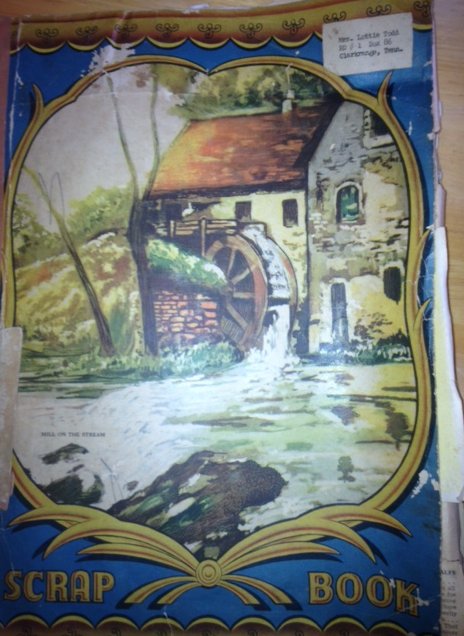"If I had a Remembrance Book..."
/Do you remember Laura Ingall's opening line, "If I had a remembrance book..." as she thought of all the things she would surely write down? Do you have such a book? Are you one of those folks that has volumes of bound books lined up on a shelf with all of your thoughts and emotions carefully chronicled?
I know that journaling can be a wonderful tool for many people. Whether you are writing your deepest thoughts or jotting down craft ideas, just putting pen to paper sorts thoughts and solidifies ideas. I confess that I have never consistently kept a journal even though I realize the benefits. But I sure am glad other folks have kept them and today I want to share one example with you.
Lottie Perie Todd was my great-great-grandmother. She lived her entire adult life in Martha Washington, Tennessee where she raised eleven children, encouraged innumerable neighbors, helped to start a Sunday School and finally passed away in 1948 at the age of seventy-six. During the last few years of her life she was bedridden and during this period which she recorded many of the ordinary happenings in her home.
She records major historical events such as, “Surrender of Germany May 7, 1945”. She records the weather, “Snow December 31, 1945”. She records both visitors to her home and visits made by her household, “April 5 Thomas came,” and “April 6 Delsie visited Mrs. Cooper”. She records purchases made for the household, “November 12 Dad got a well chain…” as well as gifts given to them, “April 29 Tom gave me a tablet”. She records the progress of the family canning, “July 24 canned four jars of preserved peaches and eleven quarts canned peaches and thirteen quarts of blackberries and eleven jars of cucumber pickles”.
When Lottie’s health rendered her too weak to write, her daughter Delsie assumed the responsibility. Do you imagine that while Lottie was feeling low, the continuance of this report was a comfort to her? September 16, 1946 she notes “The last letters I wrote. I have quit my writing.” This must have been a very sad day for her. However, by July 1947, a new book opens with, “Clarence, Mary [and] Jerry went to visit Dewey and Ova [and] went fishing. Mary picked blackberries.”
There are several little books that span 1944 through 1948. They mention what today would seem a tiny gift such as fifty cents but there is also a silk gown gifted to Lottie. She is sending grandsons off to war while welcoming new babies. She records purchases of a broom, mop and hog feed. Cows have calves, her son-in-law’s mare dies and all are noted. From these simple facts jotted down in plain notebooks, we glimpse the daily life of her extended family.
It isn’t hard to read between the lines and see real emotion. With a family tree beside the books, it’s easy to trace the identities of most of the characters and if you know the community, the neighbors come into focus as well. Lottie worries for family members and neighbors equally. Her concern is clear for a grandchild receiving treatments for eczema and for her daughter who will have to pay $40.50 to have her son’s tonsils removed. When Cal Farley dies suddenly, her heart goes out to the Farley family and her husband and daughter go to visit the widow. When she learns that a neighbor’s son has received a prison sentence for an accident resulting from drunken driving she is as shocked and hurt as his own parents.
I’ve read through this diary several times and I find myself more interested each time. Somehow, it draws me into their lives just as a well-written novel does and I find that truly funny since I spend so much energy trying to develop characters and plot lines that leave my readers glued to the pages. This is the original reality show and today’s often-bizarre reality TV has nothing on it.
It is beautiful to see the constant stream of visitors coming to see this invalid. On her seventy-fourth birthday she is surrounded by loved ones including Reverend Bilbrey, Reverend Robinson and Reverend Tinch – three preachers and let me assure you that there were no mega-churches in the vicinity employing a full preaching staff.
Sweeter still is that this little home was so open and welcoming. People must have enjoyed being there or they would not have come again and again. People came to stay the night or the weekend; they brought what they could spare and shared whatever the Todds had. While Lottie lay bedridden, her family came alongside her and continued to manage the garden, livestock and household making her final years no doubt as joyous as though this illness had never befallen her.
She also kept a scrapbook with cards, newspaper clippings, a few letters she received as well as small gifts. There are several souvenir handkerchiefs from France and Belgium as well as a Japanese Yen no doubt sent by family and neighbors serving in World War II.
I suppose the primary reason I’ve never kept a journal was simply lack of anything to record. Mrs. Lottie Todd might have thought she had nothing exciting going on in her little world, yet she has left a work that four generations later is still touching hearts and bringing smiles. Do you think in sixty or seventy years our children and grandchildren might be interested to read about the things we do in our simple little lives?








